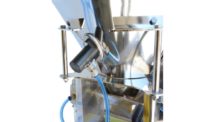Company: Martin Vibration Systems Solutions
Website: www.shake-it.com
Equipment Snapshot: A global provider of industrial vibration equipment has introduced a versatile mounting solution for bins, hoppers and chutes—with no welding, drilling or tapping required—speeding up vibrator installation and eliminating the usual system downtime. Designed to soundly adhere to circumferences of less than 24 in. / 610 mm (including high arcs, odd angles or limited spaces), the purpose-built Martin Stick & Shake Adhesive Mounting System now allows operators to quickly and easily attach compact vibrators directly to process vessels. The result is more effective material flow at choke points, higher efficiency and reduced maintenance time.
Available for the company’s NTK 8AL HA, NTS 80 and NTP 18 vibrators, the Stick and Shake Mounting System provides all necessary components, including stainless steel face plate, mounting studs, lock washers and hex nuts, two-component adhesive cartridge, mixing nozzle, double sided adhesive strips and a convenient applicator gun. Compatible with virtually any clean surface, the glue adheres to nearly every common industrial structural material, including painted metals, polycarbonate, acrylics and ABS plastics. The low-noise, pneumatic, piston-driven Bantam series units can be mounted in any position, even when in constant use.
“Handlers of pellets, grain, powder or viscous liquids often have small hoppers, specialized vessels or cramped spaces where traditional vibration brackets won’t fit,” explained Michael Holland, product group leader at Martin Vibration Systems. “In response to customer requests, we devised a revolutionary solution that can conform tightly to a curved vessel wall, but still offer a flush and sturdy mount to attach our Bantam series of powerful compact vibrators.”
Previously, narrow system bottlenecks that were prone to clogging required a vibrator to be mounted on a flat surface or support structure. To properly agitate the hopper and maintain constant material flow, the vibrator needed to be powerful enough to shake the entire apparatus, rather than just the vessel itself. Beyond the increased energy usage of larger vibrators, over time, perpetual shaking degrades the stability of support structures and potentially reduces the life of mechanical parts, increasing the cost of operation.
By adhering directly to the wall of a hopper, bin or chute, operators are better able to apply focused energy directly to the blockage site, improving material flow with less force. Shaking only the vessel wall instead of the entire apparatus, the vibration creates separation between fragments, dislodging buildup and promoting flow, drastically reducing downtime and maintenance associated with material accumulation.
“This as a game-changer for small applications,” said Mike Lindbeck, vice president of sales and marketing for Martin Vibration Systems. “As processors seek to improve speed and efficiency, they need vibration for consistent material flow. Now, they finally have a solution for these difficult applications.”
A single worker can install the new mounting system in just a few minutes. Needing just 24 hours for full cure of the adhesive, the vibrator can be mounted, installed and working the same business day. To operate, the units require a 3-way normally closed valve and 5-micron filter regulator. All of the designs can be outfitted with timers to regulate operation and conserve power.
“Customers have told me that the ability to mount a small, energy-efficient vibrator in exactly the right spot has significantly improved their process,” Holland concluded. "Workers no longer need to monitor systems as closely or take the time to manually dislodge accumulation. Now, they either just leave the unit running or remedy the clog with a manual switch, improving throughput and reducing operating costs to deliver an excellent return on investment.”









